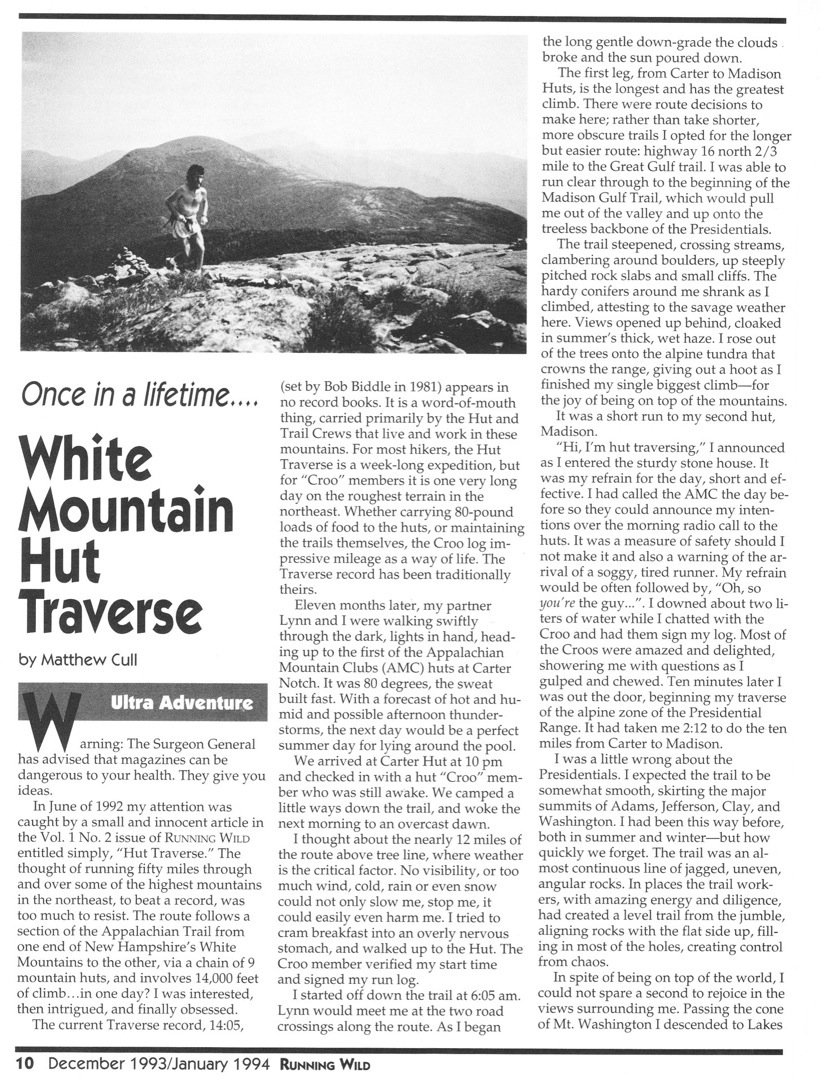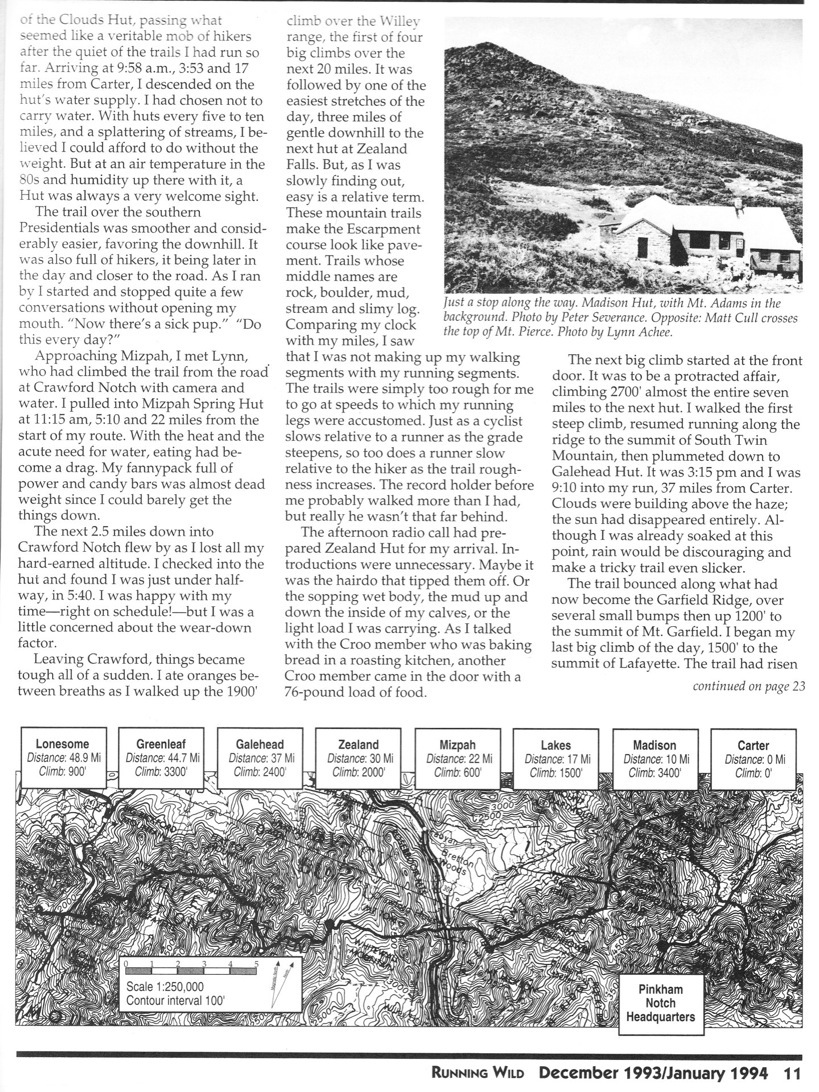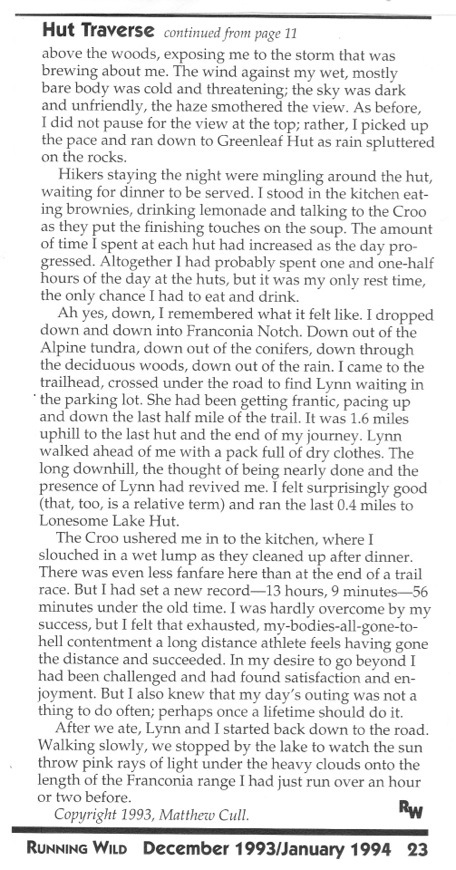Matthew J K Cull

Photographer, Speaker, Writer
World Adventure Traveler
Life’s Passion Publishing
Publications
Current Publications from Life’s Passion Publishing and Matthew Cull:
Hard Road To Nirvana, A Solo Bicycle Journey Through Tibet and Along the Himalayas
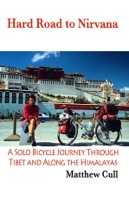
Starting in Yunnan Province of southern China, Matthew cycled alone, unsupported, and without the necessary permits, into the mountains of Tibet. Cycling roads that varied from smooth pavement to rough rocks and cobbles, he climbed high snow covered passes, crossed through deep arid canyons, and cycled past police checkpoints at night to avoid detection. His tortuous path eventually led him to Tibet’s capital, Lhasa, where he trekked through the surrounding mountains, explored its monasteries, and delved into the Tibetan Buddhist culture and its tragic relationship with its modern day overlords. His journey continued past Everest base camp and dropped into the verdant green of Nepal. Matthew continued west on the baking, chaotic plains of India before turning north, cycling deeper into the mountains, over ever higher passes, to Ladakh, to finish on the edge of the Muslim world, on the India-Pakistan cease fire line.
High Road to Nirvana is a story of a supremely difficult journey of harsh roads, high altitude, climatic extremes, and trying human circumstances. Yet it is also a thoughtful exploration of the Tibetan Buddhist lands, its people, culture, religion, landscape, and its modern day situation. It is a grand solo journey, a hard-won pilgrimage, through a dramatic and beautiful, yet unforgiving landscape, told with perspective, sensitivity, and insight.
Includes 15 photographs
$14.95 paperback
Or from Amazon:
http://www.amazon.com/s/ref=nb_sb_noss?url=search-alias%3Daps&field-keywords=matthew+cull
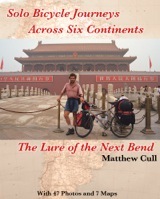
Personal adventure narrative of the author's six solo bicycle journeys through 47 countries across six continents. Over a 18 year time span Matthew cycled alone and unsupported through cultures, languages, along mountain ranges and rivers, through deserts, grasslands, tundra, and cities from the equator to above the Arctic Circle. It was a project that would see his evolution in thought, lifestyle and his view of the world and its peoples. Matthew found both the hardship, joy, and beauty of his chosen method of travel and of the lands and peoples he travelled through. His bicycle allowed him to find the isolated corners far from the beaten path and to make contact with the people, the land, and elements unhindered by metal, glass, speed or apparent affluence. Each journey was an increase in the unknowns and challenges but each journey also saw gains in skills, capabilities and confidence.The journeys were not only grand adventures and explorations across the world but a journey within.
$14.95 paperback, $7.95 E-book
Click here to purchase the paperback
Available as an E-book and paperback at Amazon:
http://www.amazon.com/s/ref=nb_sb_noss?url=search-alias%3Daps&field-keywords=matthew+cull
As an E-book at Barnes and Noble Nook:
As an E-book at Apple I-books (search matthew cull).

Titles in the series are:
Women, An International Celebration of Culture and Gender

Men, An International Celebration of Culture and Gender

Kids, An International Celebration of Culture and Children

Parent and Child, An International Celebration of Culture and Family
Faith, An International Celebration of Culture and Belief


Marketplace, An International Celebration of Culture and Commerce.
Each 96 page title comes with 100 plus rich full color images of people from around the world. PRICE REDUCED Each copy is $29.95, shipping additional.
This six book series of premium quality coffee table photo books are based on themes of common humanity. These books celebrate the cultural diversity still alive on the planet, a cultural richness that is fast disappearing. As societies across the world have become more modern and technologically adept, cultures have drifted to the irresistible lure of westernization. Traditional dress, beliefs and ways have faded, sometimes with dizzying speeds. In the not so distant future it is quite possible that all of humanity will wear jeans and T-shirts, work 9 to 5, do their shopping in huge supermarkets and come home to watch TV for the evening. Cultural diversity is going the same way as biodiversity and the world is all the poorer for it. Westernization also tends to force folks inside and out of sight. Other societies spend more of their time hanging out in public venues along the street and open air markets are standard. Cultural richness, color, and activity then have been the primary parameters for inclusion in these books and for the original desire to take the photographs. Additionally, the folks most likely to view the books will be western and the appeal will be the insight into other cultures currently largely misunderstood and under appreciated by wealthier countries.
In spite of a continual attempt by humankind to prove otherwise, the earth is still a remarkable and beautiful place brimming with life and wonder.



During 1997 I was a weekly columnist for the Vail Daily. One such edition follows.
Steppin out
by Matthew Cull
a weekly column devoted to running, snowshoeing, hiking, mountain climbing, and other individual sports that require steps, written by someone who knows better
Sponsored by the Vail Recreation District
Vail Daily Friday, July 18, 1997 Page 19
The reasons for running or getting out into the mountains are as varied as the people who participate. The physical exertion, the desire to become faster or stronger, the opportunity to inhale fresh air, a search for beautiful places or to see wildlife are just a few. Amongst those reasons is the desire, or need, to escape the race that we are a part of. Conversely, activity is a chance to be social and get together.
For many, the road, the trail or the mountains are a search for solitude and peace, to turn our modern methods of communication off, to flee the madding crowds that plague our work life, roadways and social times. It doesn't take much, living in a place such as Vail, to be quickly alone, surrounded by trees, insects and flowers. Being alone gives us an uninterrupted chance to be introspective, to consider the day and our lives, or to reach a state of meditative non-thinking. Alternatively, by being alone, we see and experience the land undistracted by others. The peace, the beauty, become our sole inputs. We become immersed and our memories far more vivid. We return refreshed and revitalized, ready for another bout with the hordes.
On the other hand, there are those that see the outdoors as a vehicle for being with friends, relatives, catching up on local news. These folks can often be heard for half a mile down the trail, jabbering away, almost oblivious to the environment they are passing through and giving the wildlife ample advance notice to get-the- hell-outa-there. Having companions is often more fun. The sense of shared experience, humor and conversation adds joviality and friendship bonding to the experience. I once read a cycle touring guidebook where the author had been on a tour of France with six friends. He had a great time, but to that day couldn't remember where they had been.
While good companionship is not only fun, in the mountains it is safer. On more challenging trips it lends a sense of confidence. One becomes a little braver knowing there is someone else to help or at least has to go through the same experience.
There are some who are stuck with the need to be outside with someone else that they will rarely venture out unless they have companionship. While this is an extreme, most of us in some way blend the beauty of solitude with the fun of company. Whether it be by sharing some outings and leaving others for friends, or, alternatively, keeping a whole sport, say running, for solitude and sharing another sport, say hiking, with friends. Yet having a companion doesn't necessarily rule out solitude. The mere presence of another, of undertaking a journey or an activity together, of sharing effort and beauty, can be company and bonding enough without the clatter of conversation.
Yet solitude is not always wanted when it arrives. With our chaotic schedules of this modern society, juggling work, relationships, kids, social obligations and other activities, getting together with friends can be far more challenging than any activity that could have been planned. It's an unfortunate, but common axiom that you lose a playmate when they have kids.
There is a great irony of living here in the mountains. Looking in the registers on the summits of Colorado's peaks, almost every one is from the Front Range towns. Very few are from the towns so close and accessible to the mountains. When I lived in Vermont, all the trail races were in the populated states of Massachusetts, Connecticut and southern New York, far from the best trails and mountains.
Yet in spite of our yearning and ventures for the solitude of the mountains, we are obsessively social creatures. We always come back from our adventures and become such willing participants in what we somehow want to escape. Living in the Vail Valley, we have chosen to be a little closer to the mountains, which have become our therapy, a little farther from the craziness mankind has created. There will always be a place for the mountains, there will always be a desire for like minded companionship in them, there will always be a need for solitude and the peace the mountains and our exertions bring to us.
Past Publications
In 2010 I was a travel correspondent for the Vail Daily newspaper (Colorado, USA) as I cycled through Iceland and Eastern Europe. The text of one of the series follows.
A Melting Memory (Appeared in the Vail Daily July 16 2010)
My journey around Iceland by bicycle continued south along the east coast. At first it was fjords, those familiar channels of blue, or grey, below towering cliff bands and dotted with lonesome farms raising sheep from tundra. I crossed the highest year round pass in Iceland. On the summit, at a measly 2050 feet, over 95% of the surrounding landscape was still covered in snow. I hiked along fjords in under brilliant blue skies and was driven to a standstill on my bicycle by winds so strong they forced me to a walk. I strolled around cute old world homes clustered around a lagoon at the head of a fjord and cycled roads empty of traffic but bursting with fjord views. I sang the praise of this beautiful country yet periodically cursed the weather that always made sure that love didn’t come easy.
As the fjords faded with distance south the glaciers kicked in with force. One of the largest ice caps on the planet, Vatnajokull, lies close against the east coast and sends mighty rivers of ice down to melt at the edge of the narrow coastal plain. I cycled past glaciers that swept down in long graceful arcs or tumbled in suspended free fall from the smooth level ice cap above. I took turn offs to moraine lakes where glaciers up to tem kilometers wide met their inevitable demise as icebergs floating in thick brown waters. Icebergs floated down short rivers to sit marooned on black sand beaches as melting memories of mountain magnificence.
I cycled below Oraefijokull, its glacial crown the highest point in Iceland at 6900 feet. At Shaktafell I hiked to a mountaintop viewpoint with a grand panorama over glaciers, waterfalls, the ice cap and the enormous glacial gravel outwash plains below them. Vatnajokull sits on top of periodically active volcanoes and craters. When these fellows grumble they can set off huge jokullkaups, glacial out-bursts, that can send water downstream in excess of two million cubic feet per second. One hundred miles of coast is vast featureless expanses of the dark grey gravel that is ground up mountains.
I cycled across these plains south-west from one ice cap to the next, the much smaller Myrdalsjokull. Laying under the flight path of April’s eruptions those glaciers weren’t nearly so pretty, ice covered in ash. Yet down in Vik, a town that had been temporarily evacuated, life couldn’t have been greener. With some of the highest temperatures and rainfall in the country the landscape was green and lush, summer's grass growing through new found soil. I cycled below the offending volcano. Steep ash covered slopes rose from the green of coast to the black ash coated glacial summit. It was peaceful now, basking in the fame of an eruption well vented.
But all this glacial beauty and summer warmth came at a price. The season’s afternoon traffic had been building with distance south and become more than I wanted from my Iceland experience. These were my roads damn it. I turned of at the first available opportunity, heading north past Hekla, one of Iceland’s more notorious volcanoes. I cycled through stark black lava landscapes and through the rich agricultural plain of the country’s south-west.
The warmth also brought out the bugs that erupted from the bushes by the cloud load. The fickle finger of fate had flipped and the wind, almost always my adversary, was now my part time ally.
I visited Geysir, home of the original, after which all other geysirs are named. And Gullfoss, the country’s most famous waterfall. Further on it was Thingvellir. One thousand years before plate tectonics had been thought about, the Vikings established the world’s first democratic parliament between the long ragged cracks in the earth’s crust that is the rift zone between Europe and North America.
Thirty three hundred kilometers and 47 days after leaving Reyjavik I rolled back into town. My cycle journey was complete, the circle was unbroken, I could hang up my wheels, at least for now. Yet my time in Iceland is not done. I will replace bicycle with backpack and set off for the hills for a couple of weeks of hiking, far from vehicles, pavement, towns, and get even closer to the wildness that is Iceland.
* * *
I was also a contributor to the magazine Running Wild, a magazine that covered off road, trail and mountain running in the US. I have included two of my articles from the magazine.
First Few Pages of Solo Bicycle Journeys Across Six Continents:The Lure of the Next Bend
I rolled down off the pass into a vast plain of grass. There was not a tree, not a feature, no point of reference. Just grass. And a narrow line of dusty gravel that was my path. The line of hills I had just crossed receded into an expanse that seemed that it could continue unabated to Lhasa. Nestled against the hills were the camps of Tibetan nomads, their dark yak wool tents set amongst seas of animals: the black of yak and dzo, the white of sheep and goat, thousands of them.
At an altitude of around 4000 meters (13,200 feet) I was in a far corner of the Tibetan plateau. I had been cycling for a week past Tibetan people, their homes and camps, villages and monasteries, folks immersed in Tibetan Buddhism, dressed in their wild loose fitting garb. They were friendly and vivacious: kids had run across the fields from tending their herds to see me as I rode by; I had been invited into one tent for tea and old stale bread; folks approached and touched my bike and equipment with innocent curiosity. But I was in China. The day before I had crossed from Gansu to Sichuan provinces and what the Chinese called Tibet (politically still China) was far to the west and south, out across that grass. It was a distinction good only on a map and in the halls of government.
Heavily laden trucks plowed the road on some obscure shortcut from Chengdu, the capital of Sichuan, to Gansu and beyond. These lumbering giants, all blue and all identical, as all trucks in China are, kicked up great clouds of white that swept across the grass with the wind, coating me, my bike and panniers and filling my lungs with pervasive dust. I stopped and walked over to a square brick building plonked out in the middle of the grass like a pimple. It was a tiny temple and I peered in through the locked gate. I could see an image of the Buddha, simple yet serene, wrapped in a gold scarf with candle holders lined up in front of it. Just the ticket if you happened to be herding your animals nearby.
The clear, still morning, that had held the early home fire smoke tight above the villages, had stirred. I kept an eye back over my shoulder as a line of intimidating dark cloud built along the hills I had climbed that morning. The road rose and fell gently across broad casual valleys, each low crest revealing the next hour or so of cycling ahead. It felt alone and isolated far from the madding crowds of Han China, far from the ugly industry and pollution that had filled too much of my 2000 kilometers (1200 miles) of riding so far in this country. It was wonderful to be at last in a landscape that I had envisioned; just me and the elements. I can do elements.
I was settling in quite nicely to this vast land. Then I felt the familiar feel of a bicycle with uncomfortably squirly handling. With a bike that weighed in at around one hundred pounds with all of its load, handling that felt like riding on a water bed usually meant one thing; soft tires from a puncture. I looked down between panniers and spokes. Sure enough my rear tire was bulging out from both sides of the rim. I may have ridden 60,000 kilometers (37,500 miles) riding across the earth on a laden bike but I continued to dread mechanical problems, even though I had been a professional bike mechanic. As I lifted my head up, feeling that mixed emotion of dread and resignation, a modern sports utility vehicle pulled up slowly beside me. I looked over to see an arm coming out of the window with a can of soda in its hand. At the other end of the arm was a maroon robed Tibetan Buddhist monk baring a broad warm smile. Juggling the bike with one hand I instinctively took the soda, without a word spoken the SUV sped off into the dust.
My frustration at the puncture instantly vaporized. As I wheeled my bike off the road, shaking my head and laughing at the vagaries of life and travel I realized that I had just happened upon one the essences of bicycle travel. Alone and self reliant, in a landscape so much bigger than I, I moved by my own power. I felt the elements, the land, its people and culture. My legs and the lure of the next bend may be the driving force but my journey flowed subject to forces I could not control. In the constant unfolding of the land, and in the winding of the road in front of me there were difficulties, joys, excitements, disappointments and sometimes the bittersweet happened all at once. Some things were expected, some came as complete surprises. There were struggles, there were exaltations. I kept my eyes and mind open and saw things I could see no other way. I reaped the rewards that came with a mode of transport that placed me among the very people, the very landscape, unhindered by glass, metal or speed, I had come to experience. I learnt about the world and I learnt about myself. It was adventure, it made me feel truly alive and I’d been hooked across six continents.
I usually never drink soda. But how could I not drink this one?
